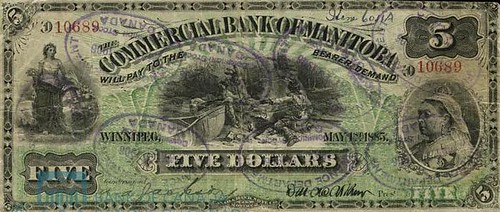
Image: Sir Hugh Allan. Source: Library and Archives Canada.
From wikipedia ‘Hugh Allen’
One of the earliest banks in Manitoba was the Commercial Bank of Manitoba, 1885 - 1893.
In 1872 Donald Smith, (Lord Strathcona) sponsored a bill to incorporate the Bank, along with some other financial institutions. The first president was Sir Hugh Allan, a shipbuilder, financier and banker. (Allan had another claim to fame - his company was awarded the first contract to build the CPR but the 1873 Pacific Scandal that brought down MacDonald saw his Allan's contract declared null and void).
The Commercial Bank of Manitoba along with three others: The Sovereign; Banque du Peuple de Montreal and The Ontario Bank, failed in an 1893 market crash.
Some blamed the crash on an over-regulated banking system at the time but it “…had been an example less of the inadequacy of the Canadian system of regulation than of the punishment which irregular banking brings in its train.” ( Source: The Quarterly Journal of Economics, Vol. 14, No. 4 (Aug., 1900), pp. 543-551).
In the end, the CBM was able to pay back its depositors.
Examples of Bank of Manitoba money:
Bank note sources: here and here. To examine the $5 in great detail go here.




1 comment:
The information in this blog is almost totally incorrect. The Commercial Bank of Manitoba was incorporated April 19, 1884 in a bill sponsored by the Honorable A. G. B. Bannatyne, J. B. McKilligan, H. Archibald, H. M. Howell and H. Vivian. Sir Hugh Allan had nothing to do with it as he was President of the Merchants Bank. The President for almost all of the bank's life was Duncan McArthur, a former manager at the Merchants Bank and principal in the private banking firm of McArthur, Boyle & Campbell. There was a financial panic in the U.S. in 1893 but it did not impact Canadian banks. The bank suspended operations on July 1, 1893 after when rumours caused several runs on it by depositors and it was running out of cash. The Merchants Bank offered to lend it some cash but the directors decided it would be better to liquidate the bank. It went into voluntary liquidation and a liquidator appointed. He was very patient in converting the banks's assets into cash and it took over 10 years before it was finally wound up. All depositors and creditors were paid in full and the shareholders received approximately $43 per share return of capital.
The other three banks mentioned in the article had nothing to do with the 1893 U..S. panic. The Sovereign Bank of Canada went into liquidation in 1907, The ONtario Bank was absorbed by the Bank of Montreal in 1906 and Le Banque de Peuple went under in 1895.
Post a Comment